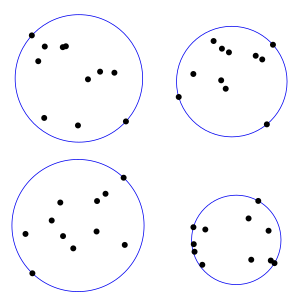
The smallest-circle problem (also known as minimum covering circle problem, bounding circle problem, least bounding circle problem, smallest enclosing circle problem) is a computational geometry problem of computing the smallest circle that contains all of a given set of points in the Euclidean plane. The corresponding problem in n-dimensional space, the smallest bounding sphere problem, is to compute the smallest n-sphere that contains all of a given set of points.[1] The smallest-circle problem was initially proposed by the English mathematician James Joseph Sylvester in 1857.[2]
The smallest-circle problem in the plane is an example of a facility location problem (the 1-center problem) in which the location of a new facility must be chosen to provide service to a number of customers, minimizing the farthest distance that any customer must travel to reach the new facility.[3] Both the smallest circle problem in the plane, and the smallest bounding sphere problem in any higher-dimensional space of bounded dimension are solvable in worst-case linear time.
- ^ Elzinga, J.; Hearn, D. W. (1972), "The minimum covering sphere problem", Management Science, 19: 96–104, doi:10.1287/mnsc.19.1.96
- ^ Sylvester, J. J. (1857), "A question in the geometry of situation", Quarterly Journal of Mathematics, 1: 79.
- ^ Francis, R. L.; McGinnis, L. F.; White, J. A. (1992), Facility Layout and Location: An Analytical Approach (2nd ed.), Englewood Cliffs, N.J.: Prentice–Hall, Inc..